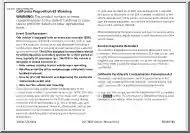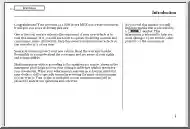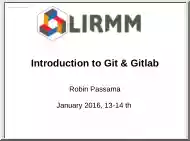No comments yet. You can be the first!
What did others read after this?
Content extract
Source: http://www.doksinet Pharmacology of inflammation Steroids (antiinflammatory action) Non-Steroidal Anti-Inflammatory Drugs (NSAIDs) Therapy of Rheumatoid Arthritis (RA) Source: http://www.doksinet Celsus (~25AD) Calor = warmth, heat Rubor = redness Tumor = swelling Dolor = pain Functio laesa = loss of function (Galen added) Source: http://www.doksinet Types of inflammation Acute inflammation Chronic inflammation Inflammation is a reaction of the microcirculation characterized by movement of fluid and leukocytes from the blood into extravascular tissues Source: http://www.doksinet . movement of fluid and leukocytes Source: http://www.doksinet Features of inflammation Neutrophils Lymphocytes Fibrin Macrophages Edema Permanent tissue changes Vascular changes [ + features of acute inflammation] Source: http://www.doksinet Molecules of cell adhesion E-, P-, and L-selectin (E-selectin
endothelial, P-selectin platelet) Intercellular adhesion molecule 1 (ICAM-1) Vascular Cell Adhesion Molecule (VCAM-1) Leukocytes integrins Source: http://www.doksinet Most important chemotactic factors C3a, C5a PAF LTB4 IL-1 TNF-α GM-CSF IL-8 Source: http://www.doksinet Pain eliciting factors Bradykinin TNFα IL-1, IL-8 SP, CGRP PGs Source: http://www.doksinet Permeability factors-- small molecules Serotonin Histamine Source: http://www.doksinet Vascular permeability factors Arachidonic acid metabolites: Leukotrienes (LTs) Prostaglandins (PGs) Source: http://www.doksinet Fever (regulation of body temperature) Set point PGE2 Cytokines •IL-1β •IL-6 •IFα, IFβ •TNFα PGE2 Source: http://www.doksinet COX and LOX pathways Source: http://www.doksinet COX isoenzymes COX-1: initial phase of inflammation COX-2 upregulated within several hours Source:
http://www.doksinet Glucocorticoids Mode of action Carbohydrate and protein metabolism Lipid metabolism Electrolyte and water balance Cardiovascular system Skeletal muscle CNS Formed elements of blood Anti-inflammatory effect •Inhibition of PLA2 •Inhibition of COX •Protein-protein intreaction between GR and NFκB and AP-1 and immunosuppressive Source: http://www.doksinet Source: http://www.doksinet COX selectivity of various NSAID Drug Selectivity Ratio (IC50 COX-2: IC50 COX-1) Aspirin Sulindac Indomethacin ‘COX-1 selective’ 166 100 60 Ibuprofen Paracetamol Less COX-1 selective 15 7.5 Equipotent on both enzymes 1.3 0.7 Flurbiprofen Diclofenac Celecoxib (Rofecoxib) COX-2 selective > 0.1 Source: http://www.doksinet Common therapeutic activities and side effects of NSAIDs (mnemonics) Antipyretic, analgesic, anti-inflammatory Low-to-moderate intensity of pain
ductus arteriosus Botalli Endometrium, uterus systemic mastocytosis Bartter’s sy (TAL ion channel genetic defect) Prevention of colon cancer nicotinic acid Ulceration Platelet Tocolytic effect renal function Intolerance Plasma albumin Source: http://www.doksinet Aspirin (acetylsalicylic acid) Spiraea ulmaria (meadowsweet) Covalently modifies both COX-1 and COX2, irreversible inhibition of cyclooxygenase activity. Duration related to the turnover rate of enzyme COX-1, aspirin acetylates serine 530, COX2, aspirin acetylates serine 516. blocks the cyclooxygenase activity COX-2 now synthesizes 15-HETE (aspirininduced asthma) Platelets (no biosynthesis): 40 mg inhibits the platelet cyclooxygenase for 8 to 11 days; (presystemic inhibition) Use: analgesic, anti-pyretic (<600 mg orally every 4 hours) anti-inflammatory agent (4 to 6 g daily) prophylactic (40 to 300 mg per day) O C O O C H O C O OH H C H H OH H C O C H H O
Source: http://www.doksinet Zileuton and aspirin intolerance 5-lipoxygenase inhibitors Complex regulation of 5-LO (Ca2+/ATP/phospholipids) This hinders in vitro assay for development of inhibitors (contrast COX) S CH3 O N HO NH2 zileuton Blocks antigen- & exercise-induced asthma. May reduce underlying inflammation. Low potency; short half-life. Other agents in development. Indirect inhibitors are also under development, that disrupt interaction of cytosolic 5-LO (inactive) with FLAP (5-lipoxygenase activating protein) at the cell membrane. Source: http://www.doksinet Effects of salicylates Analgesia Antipyresis (hyperpyeresis in toxic dose) Neurological effects (convulsions, tinnitus, nausea) Respiration (indirect and direct stimualtion) Acid-base balance and electrolyte pattern (compensated respiratory alkalosis, Toxic dose: uncompensated respiratory acidosis) Cardiovascular effects (dilation, plasma volume increses) GI effects
Hepatic effects (Reye’s sy) Uricosuric effects (dose dep.: 1-2 g/d decrease, 2-3 g/d - , 4-5 g/d increase Effects on blood Source: http://www.doksinet Pharmacokinetics (ADME) of aspirin Absorption Distribution Crosses placenta, Vd 170 ml/kg, alb bind. 80-90 % (acetylation) Metabolism Rapid, peak after 1 hour, food delays ab. Deacetylated in the plasma Three steps: salicyluric acid (rate lim), ether or phenolic glucuronid, ester or acyl glucuronide. Excretion (by urine) T1/2 15 min Source: http://www.doksinet Toxic effects of salicylates Salicylism Reye’s sy Chronic ingestion, Tinnitus, vertigo, nausea, vomiting Children, liver disorder, encephalopathy Salicylate poisoning Ox. Phosphoril uncoupling (CO2 prod increases), comp. resp alk – uncomp resp ac Source: http://www.doksinet Acetaminophen (paracetamol) toxicity Overdose Glucuronide and Sulfate conjugates NHCOCH3 CYP450 OH Hepatotoxicity
centrilobular necrosis NAPQI Source: http://www.doksinet Rumack-Matthew nomogram Source: http://www.doksinet Indomethacin Prominent anti-inflammatory and analgesic-anti-pyretic effect depress the biosynthesis of mucopolysaccharides Pharmacokinetics: rapidly and completely absorbs. Is bound to plasma albumin in 90 %. Metabolism O-demethylation, glucuronidation, Ndeacylation Enterohepatic recirculation Half life is variable Antagonises the natriuretic and antihypertensive effects of furosemide, thiazide, ACEI, B-blockers. Therapeutic uses Source: http://www.doksinet NSAIDs - Structural Classes Salicylates (aspirin, diflunisal) Propionic acid derivatives (naproxen, ibuprofen, flurbiprofen, fenbufen, ketoprofen) Acetic acid derivatives (indomethacin, sulindac, tolmetin, diclofenac, ketorolac) Fenamates (meclofenamic acid, mefenamic acid) Oxicams (piroxicam, tenoxicam) Pirazolone derivatives (phenylbutazone,
azapropazone, metamizolum Na � 4-methylaminoantipyrin (4-MAA)) Anilin derivatives (paracetamol) Alkanone derivatives (nabumeton) Others Source: http://www.doksinet Sulindac (prodrug) Less than half as potent as indomethacin Lower incidence of GI toxicity compared to indomethacin (mucosa is not exposed by the active compound) ‘Renal sparing’ NSAID Sulindac and its metabolite undergo extensive enterohepatic recirculation Therapeutic uses: RA, osteoarthritis, ankylosing spondilitis, acute gout. To reduce the number and the size of adenomas in the large bowel in familiar adenomatosus polyposis. (Sulindac sulphide is produced in the intestine by bacteria). Toxic effects: GI 20 %, CNS: drowsiness, dizziness, headache Skin rash, pruritus Source: http://www.doksinet Etodolac A quite selective inhibitor of COX-2: No GI disturbance, no platelet effect. The drug is uricosuric. Rapidly and well absorbed, albumin binding is 99%. Enterohepatic
recirculation, half life is 7 hours. Th use: postoperative analgesia, osteoarthritis, RA Sustained releaser is available (1 tbl per day). Toxic effects: skin rash, CNS in 5%. Source: http://www.doksinet Ketorolac : intermediate duration of action, approved for parenteral administration. Is used successfully to replace morphine to treat postsurgical pain (no longer than 5 days), ophthalmic preparation is available (for the treatment of seasonal allergic conjunctivitis and ocular inflammation). Should not be used for obstetric analgesia. Source: http://www.doksinet Diclofenac RA, osteoarthritis, ankylosing spondylitis, acute musculoskeletal injury, acute painful shoulder, postoperative pain, dysmenorrhoea. Reduce intracellular concentrations of free arachidonates in leukocytes (by altering the release or uptake of fatty acids) Rapidly absorbs, but bioavailability is 50% (first pass effect) Albumin binding is 99%
Accumulates in synovial fluid CYP2C9 and CYP3A4 Formulations: Intermediate release form: Cataflam Delayed-release form (Voltarin) Extended-release form (Voltarin-XR) Formulated with misoprostol: Artrotec Toxic effects: GI, elevation of serum aminotransferases Source: http://www.doksinet Source: http://www.doksinet Propionic acid derivatives Ibuprofen: rapidly absorbs, half life 2 hours, more than 99% is bound to albumin. Synovail spaces the concentration is higher Toxic effects: GI (less than in case of aspirin), skin rashes, headache, dizziness, blurred vision, edema. Not recommended to a pregnant women Naproxen Fully absorbs, 99% is bound to albumin, CYP2C9, CYP1A2, CYP2C8 Fenoprofen 85% absorbs, presence of food lowers the absorption, 99% is bound to albumin, extensively metabolized and excreted by the urine. Toxicity: rarely interstitial nephritis Ketoprofen Stabilize lysosomal membranes and may antagonize the actions of bradykinin.
Inhibits the LOX Rapidly absorbs, 99% bound to albumin, glucuronidation, enterohepatic recirculation. Source: http://www.doksinet Enolic acids (oxicams) Piroxicam: RA, osteoarthritis, may be tolerated better than aspirin or indomethacin, ankylosing spondilitis, acute musculoskeletal disorder, dysmenorrhoea, postoperative pain, acute gout. Half life is long: single daily dose is necessary. Completly absorbs, CYP2C, glucuronidation, enterohepatic recirculation, half life 50 hours, 99% is protein bound. Can reduce the Li renal secretion. Source: http://www.doksinet Voluntary withdrawal of VIOXX “We are taking this action because we believe it best serves the interests of patients. Although we believe it would have been possible to continue to market VIOXX with labeling that would incorporate these new data, given the availability of alternative therapies, and the questions raised by the data, we concluded that a voluntary withdrawal is the responsible course to
take.” Raymond V. Gilmartin, chairman, president and chief executive officer of Merck. Source: http://www.doksinet Pharmacotherapy of Rheumatoid Arthritis (RA) immunologic disease, joints are attacked bilaterally� decreased mobility and quality of life. Long term therapy is necessary HLADR4 allele is a genetic risk factor for RA RA manifest after infection (myoplasma, CMV, EBV, parvovirus) of patients with genetic risk factors. � rheumatoid synovitis, hyperplasia of the lining layer and mononuclear infiltrates in the sublining layer, microvascular injury. Clinical manifestations: articular and extraarticular (rheumatoid nodules, rheumatoid vasculitis, pleuropulmonary manifestations, neurologic manifestations (+Sjögren’s sy.), Felty’s sy (chr RA, splenomegaly, neutropenia, in occasion anemia, thrombocytopenia) � high titers of RA factor in the plasma Source: http://www.doksinet Treatment of RA NSAIDs DMARDs •Methotrexate (aminoimidazolecarboxamide
ribonucleotide (AICAR) transformylase, thymidilate synthase) •Alkylating agents (chlorambucil, cyclophosphamide) •Cyclosporine •Azathioprine •Antimalarial drugs (chloroquin, hydroxycholroquin) •Gold •Penicillamine •Sulfasalazine •Anti-TNF-α drugs (infliximab, etanercept •Leflunomide •Glucocorticoids Source: http://www.doksinet Felix Hoffmann Source: http://www.doksinet
endothelial, P-selectin platelet) Intercellular adhesion molecule 1 (ICAM-1) Vascular Cell Adhesion Molecule (VCAM-1) Leukocytes integrins Source: http://www.doksinet Most important chemotactic factors C3a, C5a PAF LTB4 IL-1 TNF-α GM-CSF IL-8 Source: http://www.doksinet Pain eliciting factors Bradykinin TNFα IL-1, IL-8 SP, CGRP PGs Source: http://www.doksinet Permeability factors-- small molecules Serotonin Histamine Source: http://www.doksinet Vascular permeability factors Arachidonic acid metabolites: Leukotrienes (LTs) Prostaglandins (PGs) Source: http://www.doksinet Fever (regulation of body temperature) Set point PGE2 Cytokines •IL-1β •IL-6 •IFα, IFβ •TNFα PGE2 Source: http://www.doksinet COX and LOX pathways Source: http://www.doksinet COX isoenzymes COX-1: initial phase of inflammation COX-2 upregulated within several hours Source:
http://www.doksinet Glucocorticoids Mode of action Carbohydrate and protein metabolism Lipid metabolism Electrolyte and water balance Cardiovascular system Skeletal muscle CNS Formed elements of blood Anti-inflammatory effect •Inhibition of PLA2 •Inhibition of COX •Protein-protein intreaction between GR and NFκB and AP-1 and immunosuppressive Source: http://www.doksinet Source: http://www.doksinet COX selectivity of various NSAID Drug Selectivity Ratio (IC50 COX-2: IC50 COX-1) Aspirin Sulindac Indomethacin ‘COX-1 selective’ 166 100 60 Ibuprofen Paracetamol Less COX-1 selective 15 7.5 Equipotent on both enzymes 1.3 0.7 Flurbiprofen Diclofenac Celecoxib (Rofecoxib) COX-2 selective > 0.1 Source: http://www.doksinet Common therapeutic activities and side effects of NSAIDs (mnemonics) Antipyretic, analgesic, anti-inflammatory Low-to-moderate intensity of pain
ductus arteriosus Botalli Endometrium, uterus systemic mastocytosis Bartter’s sy (TAL ion channel genetic defect) Prevention of colon cancer nicotinic acid Ulceration Platelet Tocolytic effect renal function Intolerance Plasma albumin Source: http://www.doksinet Aspirin (acetylsalicylic acid) Spiraea ulmaria (meadowsweet) Covalently modifies both COX-1 and COX2, irreversible inhibition of cyclooxygenase activity. Duration related to the turnover rate of enzyme COX-1, aspirin acetylates serine 530, COX2, aspirin acetylates serine 516. blocks the cyclooxygenase activity COX-2 now synthesizes 15-HETE (aspirininduced asthma) Platelets (no biosynthesis): 40 mg inhibits the platelet cyclooxygenase for 8 to 11 days; (presystemic inhibition) Use: analgesic, anti-pyretic (<600 mg orally every 4 hours) anti-inflammatory agent (4 to 6 g daily) prophylactic (40 to 300 mg per day) O C O O C H O C O OH H C H H OH H C O C H H O
Source: http://www.doksinet Zileuton and aspirin intolerance 5-lipoxygenase inhibitors Complex regulation of 5-LO (Ca2+/ATP/phospholipids) This hinders in vitro assay for development of inhibitors (contrast COX) S CH3 O N HO NH2 zileuton Blocks antigen- & exercise-induced asthma. May reduce underlying inflammation. Low potency; short half-life. Other agents in development. Indirect inhibitors are also under development, that disrupt interaction of cytosolic 5-LO (inactive) with FLAP (5-lipoxygenase activating protein) at the cell membrane. Source: http://www.doksinet Effects of salicylates Analgesia Antipyresis (hyperpyeresis in toxic dose) Neurological effects (convulsions, tinnitus, nausea) Respiration (indirect and direct stimualtion) Acid-base balance and electrolyte pattern (compensated respiratory alkalosis, Toxic dose: uncompensated respiratory acidosis) Cardiovascular effects (dilation, plasma volume increses) GI effects
Hepatic effects (Reye’s sy) Uricosuric effects (dose dep.: 1-2 g/d decrease, 2-3 g/d - , 4-5 g/d increase Effects on blood Source: http://www.doksinet Pharmacokinetics (ADME) of aspirin Absorption Distribution Crosses placenta, Vd 170 ml/kg, alb bind. 80-90 % (acetylation) Metabolism Rapid, peak after 1 hour, food delays ab. Deacetylated in the plasma Three steps: salicyluric acid (rate lim), ether or phenolic glucuronid, ester or acyl glucuronide. Excretion (by urine) T1/2 15 min Source: http://www.doksinet Toxic effects of salicylates Salicylism Reye’s sy Chronic ingestion, Tinnitus, vertigo, nausea, vomiting Children, liver disorder, encephalopathy Salicylate poisoning Ox. Phosphoril uncoupling (CO2 prod increases), comp. resp alk – uncomp resp ac Source: http://www.doksinet Acetaminophen (paracetamol) toxicity Overdose Glucuronide and Sulfate conjugates NHCOCH3 CYP450 OH Hepatotoxicity
centrilobular necrosis NAPQI Source: http://www.doksinet Rumack-Matthew nomogram Source: http://www.doksinet Indomethacin Prominent anti-inflammatory and analgesic-anti-pyretic effect depress the biosynthesis of mucopolysaccharides Pharmacokinetics: rapidly and completely absorbs. Is bound to plasma albumin in 90 %. Metabolism O-demethylation, glucuronidation, Ndeacylation Enterohepatic recirculation Half life is variable Antagonises the natriuretic and antihypertensive effects of furosemide, thiazide, ACEI, B-blockers. Therapeutic uses Source: http://www.doksinet NSAIDs - Structural Classes Salicylates (aspirin, diflunisal) Propionic acid derivatives (naproxen, ibuprofen, flurbiprofen, fenbufen, ketoprofen) Acetic acid derivatives (indomethacin, sulindac, tolmetin, diclofenac, ketorolac) Fenamates (meclofenamic acid, mefenamic acid) Oxicams (piroxicam, tenoxicam) Pirazolone derivatives (phenylbutazone,
azapropazone, metamizolum Na � 4-methylaminoantipyrin (4-MAA)) Anilin derivatives (paracetamol) Alkanone derivatives (nabumeton) Others Source: http://www.doksinet Sulindac (prodrug) Less than half as potent as indomethacin Lower incidence of GI toxicity compared to indomethacin (mucosa is not exposed by the active compound) ‘Renal sparing’ NSAID Sulindac and its metabolite undergo extensive enterohepatic recirculation Therapeutic uses: RA, osteoarthritis, ankylosing spondilitis, acute gout. To reduce the number and the size of adenomas in the large bowel in familiar adenomatosus polyposis. (Sulindac sulphide is produced in the intestine by bacteria). Toxic effects: GI 20 %, CNS: drowsiness, dizziness, headache Skin rash, pruritus Source: http://www.doksinet Etodolac A quite selective inhibitor of COX-2: No GI disturbance, no platelet effect. The drug is uricosuric. Rapidly and well absorbed, albumin binding is 99%. Enterohepatic
recirculation, half life is 7 hours. Th use: postoperative analgesia, osteoarthritis, RA Sustained releaser is available (1 tbl per day). Toxic effects: skin rash, CNS in 5%. Source: http://www.doksinet Ketorolac : intermediate duration of action, approved for parenteral administration. Is used successfully to replace morphine to treat postsurgical pain (no longer than 5 days), ophthalmic preparation is available (for the treatment of seasonal allergic conjunctivitis and ocular inflammation). Should not be used for obstetric analgesia. Source: http://www.doksinet Diclofenac RA, osteoarthritis, ankylosing spondylitis, acute musculoskeletal injury, acute painful shoulder, postoperative pain, dysmenorrhoea. Reduce intracellular concentrations of free arachidonates in leukocytes (by altering the release or uptake of fatty acids) Rapidly absorbs, but bioavailability is 50% (first pass effect) Albumin binding is 99%
Accumulates in synovial fluid CYP2C9 and CYP3A4 Formulations: Intermediate release form: Cataflam Delayed-release form (Voltarin) Extended-release form (Voltarin-XR) Formulated with misoprostol: Artrotec Toxic effects: GI, elevation of serum aminotransferases Source: http://www.doksinet Source: http://www.doksinet Propionic acid derivatives Ibuprofen: rapidly absorbs, half life 2 hours, more than 99% is bound to albumin. Synovail spaces the concentration is higher Toxic effects: GI (less than in case of aspirin), skin rashes, headache, dizziness, blurred vision, edema. Not recommended to a pregnant women Naproxen Fully absorbs, 99% is bound to albumin, CYP2C9, CYP1A2, CYP2C8 Fenoprofen 85% absorbs, presence of food lowers the absorption, 99% is bound to albumin, extensively metabolized and excreted by the urine. Toxicity: rarely interstitial nephritis Ketoprofen Stabilize lysosomal membranes and may antagonize the actions of bradykinin.
Inhibits the LOX Rapidly absorbs, 99% bound to albumin, glucuronidation, enterohepatic recirculation. Source: http://www.doksinet Enolic acids (oxicams) Piroxicam: RA, osteoarthritis, may be tolerated better than aspirin or indomethacin, ankylosing spondilitis, acute musculoskeletal disorder, dysmenorrhoea, postoperative pain, acute gout. Half life is long: single daily dose is necessary. Completly absorbs, CYP2C, glucuronidation, enterohepatic recirculation, half life 50 hours, 99% is protein bound. Can reduce the Li renal secretion. Source: http://www.doksinet Voluntary withdrawal of VIOXX “We are taking this action because we believe it best serves the interests of patients. Although we believe it would have been possible to continue to market VIOXX with labeling that would incorporate these new data, given the availability of alternative therapies, and the questions raised by the data, we concluded that a voluntary withdrawal is the responsible course to
take.” Raymond V. Gilmartin, chairman, president and chief executive officer of Merck. Source: http://www.doksinet Pharmacotherapy of Rheumatoid Arthritis (RA) immunologic disease, joints are attacked bilaterally� decreased mobility and quality of life. Long term therapy is necessary HLADR4 allele is a genetic risk factor for RA RA manifest after infection (myoplasma, CMV, EBV, parvovirus) of patients with genetic risk factors. � rheumatoid synovitis, hyperplasia of the lining layer and mononuclear infiltrates in the sublining layer, microvascular injury. Clinical manifestations: articular and extraarticular (rheumatoid nodules, rheumatoid vasculitis, pleuropulmonary manifestations, neurologic manifestations (+Sjögren’s sy.), Felty’s sy (chr RA, splenomegaly, neutropenia, in occasion anemia, thrombocytopenia) � high titers of RA factor in the plasma Source: http://www.doksinet Treatment of RA NSAIDs DMARDs •Methotrexate (aminoimidazolecarboxamide
ribonucleotide (AICAR) transformylase, thymidilate synthase) •Alkylating agents (chlorambucil, cyclophosphamide) •Cyclosporine •Azathioprine •Antimalarial drugs (chloroquin, hydroxycholroquin) •Gold •Penicillamine •Sulfasalazine •Anti-TNF-α drugs (infliximab, etanercept •Leflunomide •Glucocorticoids Source: http://www.doksinet Felix Hoffmann Source: http://www.doksinet




 When reading, most of us just let a story wash over us, getting lost in the world of the book rather than paying attention to the individual elements of the plot or writing. However, in English class, our teachers ask us to look at the mechanics of the writing.
When reading, most of us just let a story wash over us, getting lost in the world of the book rather than paying attention to the individual elements of the plot or writing. However, in English class, our teachers ask us to look at the mechanics of the writing.